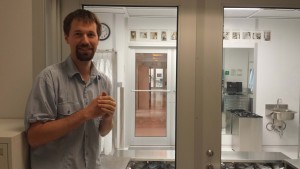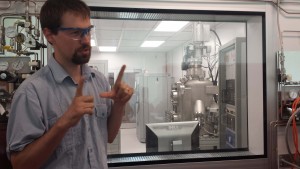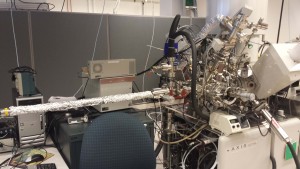
Scientists aren’t as uptight or as mad as the stereotypical personalities shown in popular media. No, they buy burgers for the BBQ, drop off dry cleaning and use public transit—just like everybody else. I know for a fact that some even go “squee!”…but not so much over kittens (okay, maybe about kittens too).
So, how do I know about the “squee!” bit?
Well, a couple of weeks ago I was guilty of a squee! and so were two other Talk Science to Me team members, mastermind Eve Rickert and associate editor Roma Ilnyckyj, as we toured SFU’s impressive 4D LABS facility on the Simon Fraser University Burnaby campus. Each turn of the corridor seemed to bring new laboratory delights in the shape of adorable compact electron microscopes, bright and shiny clean lab facilities, and a laser lab that belongs in a Marvel superhero film set.
Squee! indeed.
 Our tour, led by 4D LABS director of operations Nathanael Sieb, took Eve, Roma and me past clean room facilities bathed in orange light, where researchers could work dustless on nanofabrication lithography procedures without damaging their work with stray UV light or particles. We peeked into labs set up with materials fabrication equipment that could create layered screens for smartphones and tablets or intricate circuitry for fuel cell components. We hovered outside a room containing a SQUID that characterized magnetics (okay, a superconducting quantum interference device), and took a stroll around the five inhabitants (scanning and transmission) of the electron microscopy suite, where Eve reminisced about working on a 1970s–era electron microscope the size of an entire room.
Our tour, led by 4D LABS director of operations Nathanael Sieb, took Eve, Roma and me past clean room facilities bathed in orange light, where researchers could work dustless on nanofabrication lithography procedures without damaging their work with stray UV light or particles. We peeked into labs set up with materials fabrication equipment that could create layered screens for smartphones and tablets or intricate circuitry for fuel cell components. We hovered outside a room containing a SQUID that characterized magnetics (okay, a superconducting quantum interference device), and took a stroll around the five inhabitants (scanning and transmission) of the electron microscopy suite, where Eve reminisced about working on a 1970s–era electron microscope the size of an entire room.
 4D LABS, envisaged in 2004 by SFU chemistry professor Ross Hill and in operation since 2007, is a materials science research institute that offers state-of-the-art equiment and facilities to researchers in nanofabrication, nanoimaging and laser technology. It is a key component of the purpose-built TASC2 (Technology and Science Complex) building on the SFU campus. Housing more than $35 million worth of equipment, the facility offers a centralized resource for university, industry and local researchers in materials science characterization and fabrication. Since opening, the laboratories have served academics from Australia, Ontario and Western Washington, in addition to SFU scientists, local industries and visitors from neighbouring institutions. With a full-time staff of 10, 4D LABS maintains the equipment and trains users so they can work safely and productively at all times. With shared resources and storage, everything is provided—even clean room notebooks and pens.
4D LABS, envisaged in 2004 by SFU chemistry professor Ross Hill and in operation since 2007, is a materials science research institute that offers state-of-the-art equiment and facilities to researchers in nanofabrication, nanoimaging and laser technology. It is a key component of the purpose-built TASC2 (Technology and Science Complex) building on the SFU campus. Housing more than $35 million worth of equipment, the facility offers a centralized resource for university, industry and local researchers in materials science characterization and fabrication. Since opening, the laboratories have served academics from Australia, Ontario and Western Washington, in addition to SFU scientists, local industries and visitors from neighbouring institutions. With a full-time staff of 10, 4D LABS maintains the equipment and trains users so they can work safely and productively at all times. With shared resources and storage, everything is provided—even clean room notebooks and pens.
But back to the excitement. The biggest squee! was reserved for the X-ray photoelectron spectrometer: a silver beast of a machine, with many arms pointing in all directions of the compass. The XPS spectrometer took up an entire bench and room. As an embodiment of stereotypical labware, this amazing-looking piece of equipment provides chemical state and bonding information and elementally maps surfaces. And it’s just one of the totally awesome pieces of kit available in the 4D LABS facility.
spectrometer took up an entire bench and room. As an embodiment of stereotypical labware, this amazing-looking piece of equipment provides chemical state and bonding information and elementally maps surfaces. And it’s just one of the totally awesome pieces of kit available in the 4D LABS facility.
For a scientist, 4D LABS is the stuff of dreams. I remember writing grants, limiting experimental design with a touch of realism to the equipment either already available or from the lab next door. Occasionally, and with hope at my fingertips as I typed, I’d throw in a financial plea for the stuff of aspirational daydreams. Having a facility like 4D LABS available would have simplified my research life. With an impressive array of state-of-the-art equipment and experienced staff to manage the facility, all you need to bring along are your dreams—4D LABS supplies everything else that your scientific heart could desire.